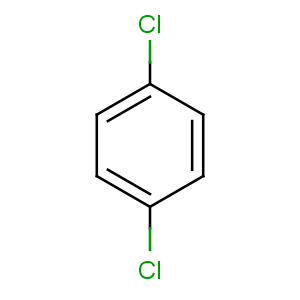Title: p-Dichlorobenzene
CAS Registry Number: 106-46-7
Synonyms: Paracide; PDB
Trademarks: Paradichlorobenzene; Para-zene (Reliable Chem.); Di-chloricide; Paramoth (Esquire)
Molecular Formula: C6H4Cl2
Molecular Weight: 147.00
Percent Composition: C 49.02%, H 2.74%, Cl 48.24%
Literature References: Prepn and separation from
m- and
o-dichlorobenzene,
see m-dichlorobenzene. Crystal structure of triclinic form (b-modification): Housty, Clastre,
Acta Crystallogr. 10, 695 (1957); of monoclinic form (a-modification) and transformation to triclinic form: Panatoni
et al., Gazz. Chim. Ital. 93, 813 (1963). Manuf:
Faith, Keyes & Clark's Industrial Chemicals, F. A. Lowenheim, M. K. Moran, Eds. (Wiley-Interscience, New Yok, 4th ed., 1975) pp 258-265. Toxicity study: T. B. Gaines, R. E. Linder,
Fundam. Appl. Toxicol. 7, 299 (1986). Review of toxicology:
Rev. Environ. Contam. Toxicol. 106, 51-68 (1988); and human exposure:
Toxicological Profile for 1,4-Dichlorobenzene (PB99-121972, 1998) 300 pp.
Properties: Volatile crystals with a characteristic penetrating odor. Sublimes at ordinary temps. mp 53.5° (a-modification), 54° (b-modification). bp 174.12°.
nD60 1.5285. Flash pt (closed cup) 150°F. Log P (olive oil/water) 3.65. Vapor pressure (25°) = 0.4 mm Hg. d20 1.46. Practically insol in water. Sol in alcohol, ether, benzene, chloroform, carbon disulfide. Non-corrosive; non-staining. LD50 in male, female rats (mg/kg): 3863, 3790 orally; >6000, >6000 dermally (Gaines, Linder).
Melting point: mp 53.5° (a-modification), 54° (b-modification)
Boiling point: bp 174.12°
Flash point: Flash pt (closed cup) 150°F
Index of refraction: nD60 1.5285
Log P: Log P (olive oil/water) 3.65
Density: d20 1.46
Toxicity data: LD50 in male, female rats (mg/kg): 3863, 3790 orally; >6000, >6000 dermally (Gaines, Linder)
CAUTION: Potential symptoms of overexposure are eye irritation, periorbital swelling; profuse rhinitis; headache; anorexia, nausea and vomiting; weight loss, jaundice and cirrhosis.
See NIOSH Pocket Guide to Chemical Hazards (DHHS/NIOSH 97-140, 1997) p 96. Direct contact with fumes or solid may cause skin irritation.
See Patty's Industrial Hygiene and Toxicology vol. 2B, G. D. Clayton, F. E. Clayton, Eds. (Wiley-Interscience, New York, 3rd ed., 1981) pp 3617-3626. This substance is reasonably anticipated to be a human carcinogen:
Report on Carcinogens, Eleventh Edition (PB2005-104914, 2004) p III-85.
Use: Insecticidal fumigant. For domestic use against clothes moths; as space deodorant in room deodorizers, toilet bowl blocks and diaper pail deodorizers. Intermediate in production of plastics for electronic components.

